The Falcons

HANDSWORTH BIRMINGHAM
Revised July 2020
Tony Haines vocal/washboard/drums
Arthur Rogers lead vocal, tea chest bass
Ron Drew lead guitar
Johnny Aitken rhythm guitar (left 1958)
Kevin Hateley vocal/guitar (left 1958)
John Keeling vocal/guitar (joined 1958, left 1963)
Malcolm ? bass guitar
The photo of "The Falcons" shown here was taken in 1960 at The Crown and Cushion in Perry Barr. The line-up left to right is; Ron Drew, Tony Haines, Arthur Rogers, John Keeling, and Malcolm (?) NOTE: this is not the same Falcons (a later beat group) that a young Roy Wood played guitar in.
While the new "Rock 'N' Roll" was taking America by storm during the mid 1950s, it was "Skiffle" music that was making an impact with teenagers in Britain during that time. "Big bands", "jazz", and adult oriented singers appealed to an older audience, but younger people soon embraced home-made skiffle music as their own form of musical self-expression. Local music historian and BrumBeat contributor Brian Nicholls tells the story of Handsworth skiffle group "The Falcons" as follows;
"Rock Island Line"
In the Autumn of 1957 Tony Haines, Arthur Rogers, Ron Drew, Johnny Aitken and Kevin Hateley, like many young lads in communities across Britain, got together to play skiffle (for a bit of fun) and called themselves "The Falcons".
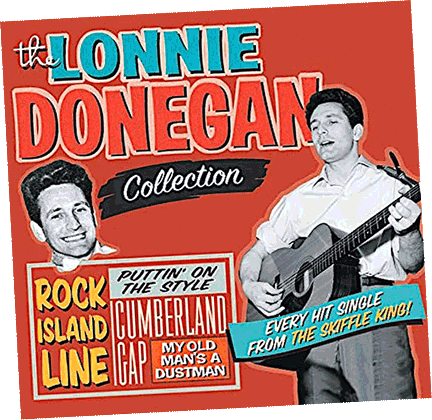
They were routinely all gathered around the radio listening to the weekly Saturday Skiffle Club on the BBC Light Programme at 10.00 every week jotting down the song lyrics from famous artists like Chris Barber, Lonnie Donegan, Chas McDevitt, Johnny Duncan, The Vipers etc. plus the array of guest amateur skiffle groups.
This programme was hosted by Brian Matthew since its inception on 1st June, 1957 and by October, it was boasting two and a half million listeners. Skiffle had a shelf-life of around two years and reached its peak in 1957. It had its roots in Delta blues, Folk, New Orleans jazz and Barrelhouse.
The skiffle explosion actually kicked off in January, 1956 with Lonnie Donegan's smash hit on both sides of the Atlantic ('Rock Island Line'/'John Henry') It was a cover of Huddie ("Lead Belly") Leadbetter's folk-blues original from the 1920s. Donegan was soon to be accredited for increasing the sales of acoustic guitars in Britain from 2,500 a year to 250,000. These were cheap European guitars (and banjos) sold by mail order stores like "Headquarters" and "General Supplies" or, high street chain stores like "Woolworths".
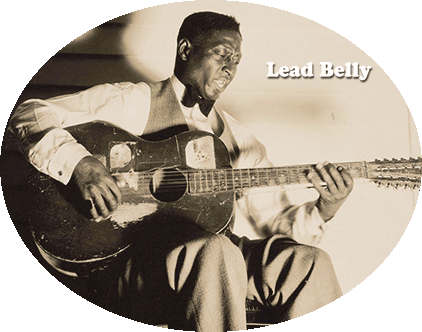
You could get one of these guitars for 20 shillings a week on the "never never". They were crude and virtually unplayable past the third fret but, they almost sounded like real guitars and it was much better than miming to records in front of your dressing table mirror with a tennis racquet or cricket bat! Although we didn't know it at the time, Donegan himself made it all look very easy and inviting as he was strumming away on a gorgeous American-made Martin D18 "Dreadnought" acoustic!
'Rock Island Line' was a totally acoustic recording with Donegan on guitar, Chris Barber on double bass, and jazz singer Beryl Bryden on washboard but, it sounded great and it was a game changer that sold three million records. If you could play the chords of A, D, and E, you were in!
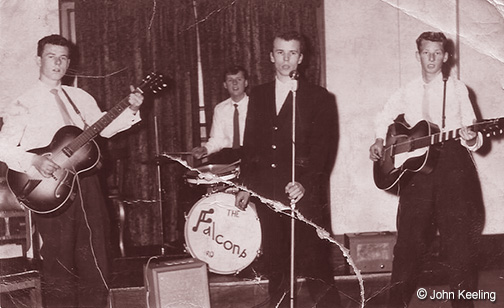
The Falcons managed to avoid the aforementioned twenty bob a week boxwood acoustics by choosing instead such models as a "Broadway archtop", "Hofner Club 50", "Rosetti Lucky 7", and "Guyatone". Amplifiers were typically 5 to 10 watts, eventually settling on 15w Selmers. Like all groups at the time, unless you had the 'luxury' of the Bingo calling PA of a social club the microphones went through the guitar amps.
The Falcons put in many hours of serious acoustic practice in their bedrooms and also in rehearsals and gigs at "Cocky's Social Club" in Mornington Road, Smethwick. On one particular Saturday evening in early 1958 they had entered a skiffle competition held at the club and got to the finals to be held at the Birmingham Hippodrome where Jim Dale was appearing top of the bill.
The Falcons came third with Birmingham's Modernaires and Grasshoppers coming first and second respectively. Whilst all this was going on in Handsworth, skiffle groups like "The Quarrymen" in Liverpool and "The Railroaders" in Newcastle were doing much the same thing but, luck was particularly evident on both their side as, in a few years time they were eventually to become "The Beatles" and "The Shadows" respectively.
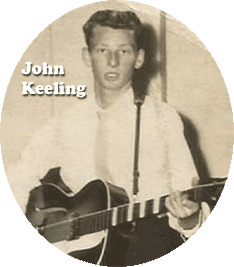
In late 1958, Kevin Hateley and Johnny Aitken lost interest in music and left The Falcons. Tony Haines' cousin, fifteen-year old John Keeling from Quinton joined the group but, in all weathers he had to cycle all the way to Handsworth for rehearsals with a guitar strapped to his back. Tony switched from washboard to drums at this point, Arthur Rogers dumped the tea chest bass and became lead singer and, a very much improved Ron Drew remained on lead guitar. The Falcons continued performing but, without a bassist.
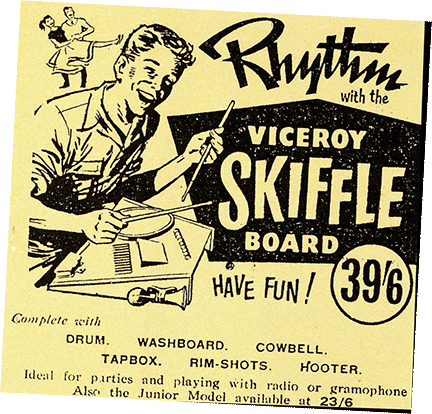
In 1958, rock 'n' roll was taking over from skiffle and groups like "The Vipers" and "The Chas McDevitt Skiffle Group" were starting to embrace the new music in their acts alongside their skiffle sets because after all, it was all rooted in folk/blues anyway. Groups were aspiring towards drum kits and electric guitars and basses.
In more recent times, Chas McDevitt has gone on record as saying; "The washboard itself was a bit of an anachronism and so too were its players. They acquired the sort of aura afforded these days to the trad banjo player - a few sandwiches short of a picnic."
Congregations of "washboardists" will collectively discuss the gauge of the metal and the frequency of the corrugations or even the metal itself (galvanised v stainless). Then there's thimbles! How quickly they wear out, where do you find the various sizes (the consensus was sizes 11 and 12) and, who manufactures the most musical ones? The holy grail of washboards was the "Columbus Washboard Maid Rite" (made in USA) and house brand thimbles from 'G Street Fabrics of Rockville.
"C'mon pretty baby let's move it"
In 1958, The Falcons had discovered Buddy Holly, Elvis Presley, Little Richard, Gene Vincent and The Bluecaps, Eddie Cochran, Jerry Lee Lewis and Cliff Richard and The Drifters (later, The Shadows after a threatened lawsuit from the American Drifters). By the end of 1958 skiffle, although still popular with many followers, was falling from grace in favour of American rock 'n' roll influences and 'Move It' by Cliff Richard and The Drifters had had a profound affect on skifflers on an industrial scale.
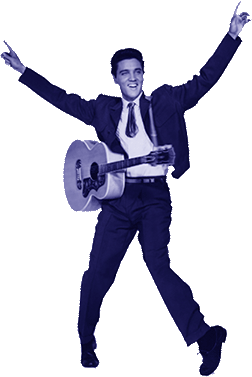
However, The Falcons still had plenty of local bookings in and around Handsworth but, had to get to them under their own steam as they had accumulated the basic gear but, no transport of their own. Luckily, Arthur was the only one in The Falcons that could drive as he was an 18 year old trainee motor mechanic so eventually, they obtained a 1938 American Nash Ambassador 'Six' followed by a 1936 Chevrolet sedan after which followed a1940 Austin 'Six' taxi and finally, an ex-MEB Bedford Dormobile.
Worn out, left over old vehicles from the late thirties and forties were in abundance at the time and could be had for around 20 pounds or less but, were usually in a terrible state and beyond redemption had the MOT test been in operation in those days. Regarding the Chevrolet, they picked it up from Feckenham in Worcestershire (advertised for free if willing to collect!). The silencer was blowing badly so it had to be towed back to Brum using the Austin Six taxi.
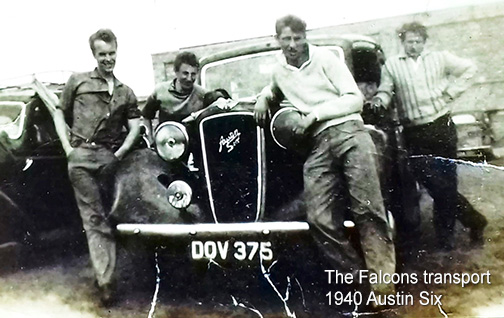
Tony had recently passed his driving test so, Arthur and Ron were were towing in the Chevy and Tony and John following in the Austin. As they turned into Winson Green Road late evening police cars with sirens blaring approached just as the tow rope snapped and the lads all froze with fear in the two cars. Luckily, the police cars roared past the Chevy and the Austin in pursuit of thieves who had just robbed a local jewellery shop.
John Keeling said; "Although Arthur was a trainee car mechanic he displayed a natural gift at fixing cars which was fortunate as the Chevy, a three-speed column change yank, could only engage first and third gears and we soon discovered reverse gear had also given up the ghost. Arthur managed for a while with gears one and three but, having to get all of us to physically man-handle the heavy beast into parking spaces was no fun. Thankfully, 18 year old Arthur removed the gearbox, took it to his place of work and reconditioned it. Now in sweet running order after a full service and tune-up we also discovered that it was typically doing only 10 miles to the gallon".
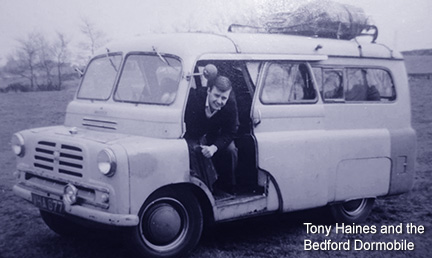
Yet another group talent competition beckoned at Birmingham's famous Locarno Ballroom, then in Corporation Street. The Falcons reached the finals but, did not reach the top three position. However, as competitors, they received free shirts from the popular Zissman Brothers tailors in Broad Street.
In early 1960 The Falcons, like all other groups at the time, decided they also had to have proper stage suits to remain competitive and so plumped for white jackets with a large red letter "F" on the breast pockets, (Tony still has his jacket and, it still fits!) red bow tie, black trousers and white "chukka" boots. They had a job finding a tailor to make the white coats but, eventually found bespoke tailor Len Roughton who had a shop near the Central Fire Station in Brum.
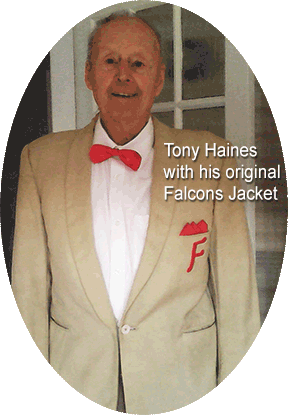
Popular Brum vocalist Keith Powell asked The Falcons to back him on an LP he was making at Hollick and Taylor's recording studios in Grosvenor Road, Handsworth. They went on to back Keith on a number of Birmingham area gigs but, mainly at The Aston Chain and Hook, and The Crown at Monkspath, Shirley. Keith's Dad promoted the weekly gigs at The Chain and Hook where he hired the works canteen.
As they became more well known around Brum, agent Ken Smith promoted The Falcons at the "Say Mama Club" in Maney Hall, Sutton Coldfield where they often shared the billing with The Rockin' Berries, and Carl Wayne and The Vikings, or Colin Storm and The Whirlwinds. Ron Drew's friend Malcolm (?) opened a record shop in Shirley and Ron went to work for him. Malcolm, a bassist, actually joined The Falcons soon after. John Keeling left the group in 1963 and laid low for a couple of years but, the group carried on until the late sixties.
Through the record shop, Ron Drew was building up his contacts in the music biz and eventually moved to London as a rep for Polydor Records. Tony Haines joined forces with a French bass player Henre Edwards (he had an English mother) as session musicians with Nicky James and Denny Laine at London's famous Abbey Road Studios.
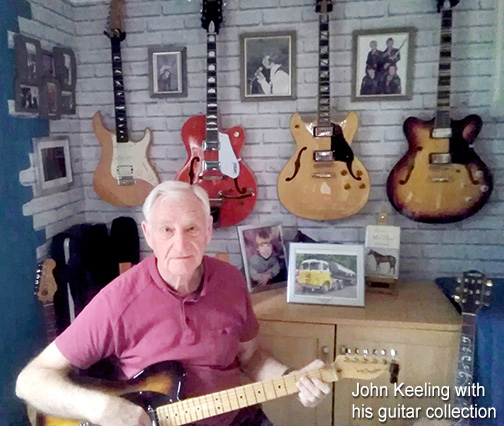
John Keeling, who provided most of the material for this article, now lives in Presteigne, Radnorshire. He went on to form "The 'K' Men" and then "Chapter III" along with cousin and former Falcons drummer Tony Haines, plus Colin Preston and Jim Fleming, to become a top cabaret act at the famous "Kingfisher" Country Club in Wall Heath during the early seventies where they opened for most of the famous names of the sixties.
In the mid seventies John Keeling formed the band "Good Company" who performed at all the prestige venues in and around Brum. John finally called it a day on New Year's Eve 1983 and opened a shoe repair shop in Quinton. These days John plays for his own enjoyment (until he gets the call!) and is a collector of interesting guitars.
Tony Haines with Arthur Rogers, and John Keeling met up at Arthur's cottage in North Wales in 2010 for a social reunion and phoned Ron Drew who at the time, lived in Swansea. Since then, they have lost contact with him but it's rumoured that Ron has moved to Cyprus to live with his sister. So, if you are reading this Ron, you know what to do!
Like all those of their contemporaries, The Falcons enjoyed what they did and are justly proud of their contribution to the local music scene.
Copyright © Brian W. Nicholls (April 2020)
Copyright © Falcons images: John Keeling (April 2020)
If you would like to contribute to this page, please e-mail john@brumbeat.net